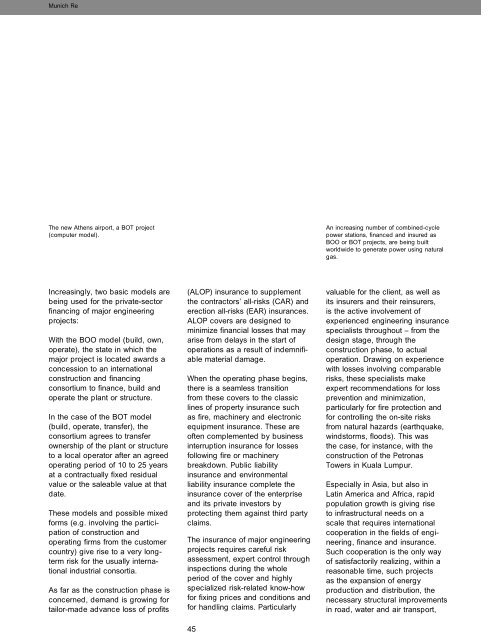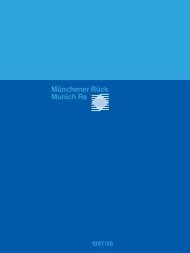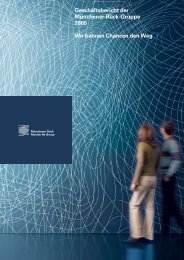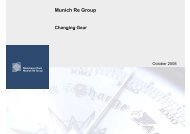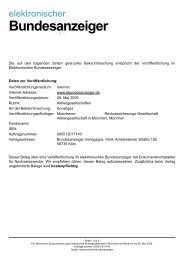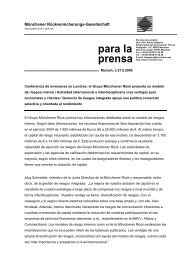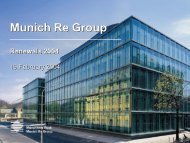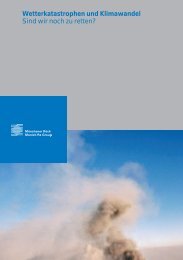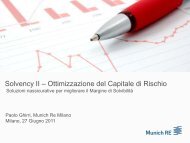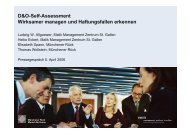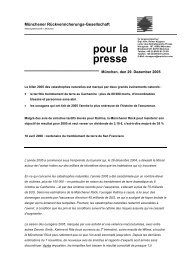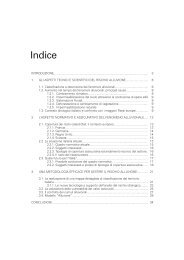Download PDF version - Munich Re
Download PDF version - Munich Re
Download PDF version - Munich Re
Create successful ePaper yourself
Turn your PDF publications into a flip-book with our unique Google optimized e-Paper software.
<strong>Munich</strong> <strong>Re</strong><br />
The new Athens airport, a BOT project<br />
(computer model).<br />
Increasingly, two basic models are<br />
being used for the private-sector<br />
financing of major engineering<br />
projects:<br />
With the BOO model (build, own,<br />
operate), the state in which the<br />
major project is located awards a<br />
concession to an international<br />
construction and financing<br />
consortium to finance, build and<br />
operate the plant or structure.<br />
In the case of the BOT model<br />
(build, operate, transfer), the<br />
consortium agrees to transfer<br />
ownership of the plant or structure<br />
to a local operator after an agreed<br />
operating period of 10 to 25 years<br />
at a contractually fixed residual<br />
value or the saleable value at that<br />
date.<br />
These models and possible mixed<br />
forms (e.g. involving the participation<br />
of construction and<br />
operating firms from the customer<br />
country) give rise to a very longterm<br />
risk for the usually international<br />
industrial consortia.<br />
As far as the construction phase is<br />
concerned, demand is growing for<br />
tailor-made advance loss of profits<br />
(ALOP) insurance to supplement<br />
the contractors’ all-risks (CAR) and<br />
erection all-risks (EAR) insurances.<br />
ALOP covers are designed to<br />
minimize financial losses that may<br />
arise from delays in the start of<br />
operations as a result of indemnifiable<br />
material damage.<br />
When the operating phase begins,<br />
there is a seamless transition<br />
from these covers to the classic<br />
lines of property insurance such<br />
as fire, machinery and electronic<br />
equipment insurance. These are<br />
often complemented by business<br />
interruption insurance for losses<br />
following fire or machinery<br />
breakdown. Public liability<br />
insurance and environmental<br />
liability insurance complete the<br />
insurance cover of the enterprise<br />
and its private investors by<br />
protecting them against third party<br />
claims.<br />
The insurance of major engineering<br />
projects requires careful risk<br />
assessment, expert control through<br />
inspections during the whole<br />
period of the cover and highly<br />
specialized risk-related know-how<br />
for fixing prices and conditions and<br />
for handling claims. Particularly<br />
45<br />
An increasing number of combined-cycle<br />
power stations, financed and insured as<br />
BOO or BOT projects, are being built<br />
worldwide to generate power using natural<br />
gas.<br />
valuable for the client, as well as<br />
its insurers and their reinsurers,<br />
is the active involvement of<br />
experienced engineering insurance<br />
specialists throughout – from the<br />
design stage, through the<br />
construction phase, to actual<br />
operation. Drawing on experience<br />
with losses involving comparable<br />
risks, these specialists make<br />
expert recommendations for loss<br />
prevention and minimization,<br />
particularly for fire protection and<br />
for controlling the on-site risks<br />
from natural hazards (earthquake,<br />
windstorms, floods). This was<br />
the case, for instance, with the<br />
construction of the Petronas<br />
Towers in Kuala Lumpur.<br />
Especially in Asia, but also in<br />
Latin America and Africa, rapid<br />
population growth is giving rise<br />
to infrastructural needs on a<br />
scale that requires international<br />
cooperation in the fields of engineering,<br />
finance and insurance.<br />
Such cooperation is the only way<br />
of satisfactorily realizing, within a<br />
reasonable time, such projects<br />
as the expansion of energy<br />
production and distribution, the<br />
necessary structural improvements<br />
in road, water and air transport,


